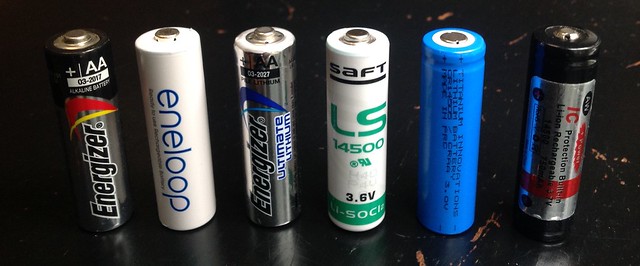I like to do run time charts for my lights and one thing that has struck me is that my Fenix PD25, Fenix E15, and Jet II MK all have more efficient run times on a 700mAh 16340 battery than the Fenix LD11 and LD12 do on a 800mAh 14500 battery. Now what I do is pick an output that is similar on all lights such as level 3 (not the turbo) and then I take the area under the curve (output times time). I found the LD11 and LD12 to lag the others by about 30% and then if you take into account that the 14500 battery I was using has 100mAh more, then that even makes the 30% even worse.
I believe the reason for this has to do with the fact that these 14500 capable lights are designed to utilize an AA battery too.........so the voltage range is 0.9v to 4.20v. Whereas the 16340 lights just use CR123A's or 16340 batteries and the voltage range is a lot nearer the forward voltage drop of the LED. That is just my guess at this time. Designing a driver to cover the range from 0.9v to 4.20v must be a lot less efficient than say a driver that just has to buck the voltage rather than to switch from buck or boost.
Now I realize that this is heavily weighed on the Fenix side, but I already know that the Nitecore MT10A switches to PWM for voltages above the Vf of the LED. The MT10A is very efficient on AA batteries though. In previous testing I found the 4Sevens Quarks that would run 0.9v to 4.2v to also drop in efficiency from other lights that are designed to just run an AA or to just run lithium ion battery.
So my conclusion is that I have taken a stronger liking to the single CR123A/16340 lights and realize that the strong point of the AA/14500 lights is their AA capability.
I believe the reason for this has to do with the fact that these 14500 capable lights are designed to utilize an AA battery too.........so the voltage range is 0.9v to 4.20v. Whereas the 16340 lights just use CR123A's or 16340 batteries and the voltage range is a lot nearer the forward voltage drop of the LED. That is just my guess at this time. Designing a driver to cover the range from 0.9v to 4.20v must be a lot less efficient than say a driver that just has to buck the voltage rather than to switch from buck or boost.
Now I realize that this is heavily weighed on the Fenix side, but I already know that the Nitecore MT10A switches to PWM for voltages above the Vf of the LED. The MT10A is very efficient on AA batteries though. In previous testing I found the 4Sevens Quarks that would run 0.9v to 4.2v to also drop in efficiency from other lights that are designed to just run an AA or to just run lithium ion battery.
So my conclusion is that I have taken a stronger liking to the single CR123A/16340 lights and realize that the strong point of the AA/14500 lights is their AA capability.


